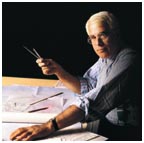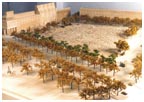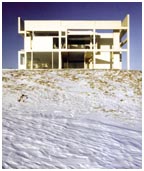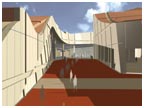April 7, 2004: Features

Visiting professor of architecture Peter Eisenman
Model of the Memorial to the Murdered Jews of Europe
Workers walk among the concrete slabs, or stelae, on the construction site in Berlin. (Photos courtesy Eisenman Architects; Sean Gallup/Getty Images (construction site)) |
Designer
of ideas
Architect Peter Eisenman is happy if his designs
provoke strong reactions
By Merrell Noden ’78
Peter Eisenman will tell you that, attuned as he is to every current of history and memory coursing through an architectural site, he is not a “futurologist.” Still, he knows what’s coming once his Memorial to the Murdered Jews of Europe opens next January in Berlin, on the 60th anniversary of the liberation of Auschwitz.
“It’s going to be very provocative,” says Eisenman, a visiting professor of architecture at Princeton. “Everybody has something to say about it: ‘Why don’t we put it someplace farther out [from the city center]?’ ‘Why don’t we make it a little smaller?’ It’s going to bring the question of latent anti-Semitism out. A lot of people rather would have had [a figurative work like] Rodin’s The Burghers of Calais, put them under a tree, and said, ‘Oh, those poor, weeping Jews.’
“The interesting thing is, there’s nothing Jewish about it, only the name,” Eisenman says of the memorial, mandated by the Bundestag to keep alive “the memory of these inconceivable events in German history.” He continues: “There are no symbols, no signs, no nothing. That’s what’s interesting to me, that an abstract thing can get people upset. I think that if you took a poll among the Germans, if you really touched their subconscious and asked what do they really think about it . . . 90 percent would be against it.”
Eisenman is amazed that the city was willing to turn over so much valuable land – 10 acres – right in the shadow of the Brandenburg Gate. On that vast site, he is erecting 2,751 gray concrete stelae. Some are as short as three feet, others as tall as 15, but they are being arranged on the uneven ground in such a way that their tops will be roughly aligned. And because each slab is 7' 6" wide and they stand only 2' 9" apart – “not as wide as the distance from your sink to your kitchen counter,” notes Eisenman – visitors will have no choice but to walk single file down its claustrophobic chasms. You won’t come to this memorial to picnic: Entering should be a disorienting, disturbing experience, which is exactly what Eisenman intends.
“Walking down into it is not nice,” he says emphatically. “When you go to Auschwitz or Treblinka, you go there and say, ‘Oh, this is horrible.’ But then your psyche integrates that experience, and you walk away. So what I needed to do for this project was to make something in the present that had nothing to do with the literal Holocaust, but would make someone feel something analogous to what it might have been like being in Auschwitz. It is a memorial like no other.”
Eisenman won the right to design the memorial in a competition in 1998, despite being conflicted about joining what he calls the “Holocaust industry.” As a thoroughly assimilated American Jew whose great-grandparents had come to this country in 1848, he did not feel a personal connection to the Holocaust. He found inspiration for the memorial in a surprising place, an Iowa cornfield – or, more precisely, in his memory of panicking when he got lost in one as a young man.
“I’d walked 100 yards in and couldn’t see my way out,” he says. “That moment was very scary. There are moments in time when you feel lost in space. I was trying to create the possibility of that experience, that frisson — something you don’t forget.”
Eisenman explains all this in a forceful, gravelly voice. He is 71 years old, with a full head of feathery white hair; he must remember to rein in the exuberance he often feels. “You have to act your age,” he noted in a talk this semester at Princeton. “Yet I feel really young. Not many 70-year-olds have a 12-year-old son.
Eisenman designs: from top, House II of 10 numbered houses, designed for the family of Princeton professor Richard Falk; pedestrian plaza in the City of Culture, Galicia, Spain; and Cardinals Stadium in Glendale, Arizona. (From top to bottom: dick frank/courtesy eisenman architects, courtesy Eisenman Architects, dbox/courtesy Eisenman Architects) |
Perhaps because he helps coach that son in both basketball and baseball, Eisenman is a whirlwind of creative energy.
Far from winding down, his career is building to a crescendo. After 40 years of working on it, last August Eisenman published a dense, technical study of two buildings in Como, Italy, designed in the 1930s by the architect Giuseppe Terragni, a rationalist architect whose work gave expression to Italy’s fascist regime. (The book, Giuseppe Terragni: Transformations, Decompositions, and Critiques, was published by Monacelli Press.)
At the same time, Eisenman has major projects under construction all over the world: a six-building cultural center in Galicia, Spain; stadiums in La Coruña, Spain, Leipzig, Germany, and Glendale, Arizona; plus the Berlin memorial. He was one of a group of New York architects selected to propose design ideas for the World Trade Center site. He lectures constantly, teaches at Yale, and, for the last 10 years, has spent each spring term at Princeton, where his long academic career began in the 1960s.
“I was denied tenure at Princeton,” he says wryly. “I was denied tenure at Harvard. I’d love to be denied tenure at Yale because then I’d have a clean sweep.” His disappointments – if that’s what they are – may have been salved when, in March, the University of Rome awarded him an honorary doctorate.
Eisenman has made a career out of being a provocateur, a fiercely polemical noodge. “Books are as important, if not more important, than buildings,” he says. “Most buildings don’t afford the opportunity to express ideas. What gets built has very little to do with what I think of as ideas about architecture.” That’s why, this winter, he was more interested in designing a museum in China that probably never will get off the ground than in less challenging projects that will. “My heart and soul are in it,” he says.
In his early days as an architect, he didn’t build a thing – he just lobbed incendiary ideas into the world of architecture in hopes, says Richard Lacayo, art and architecture critic for Time magazine, of “profoundly deconstructing the very idea of a building and how a building related to the environment it found itself in.”
Of course, in the real world in which we all sleep, eat, and work, such experiments have often been met by skepticism or outright hostility. His first project, begun in the 1960s, was to be a series of 10 numbered houses, though in the end, only four were built. House I still stands on the outskirts of Princeton, though in an altered state. House II was a doozy. Designed for Princeton politics professor Richard Falk as a “Chomskyesque house,” it was to some, the Falks included, a disastrous triumph of theory over utility: In snowy Vermont, it had a flat roof, gaps in the floor large enough for the Falks’ small son to fall through, and no walls, which meant that a whisper could be heard all over the house. Eisenman is reluctant to discuss that house now, but told the New York Times in 2002, when the house was sold, “I don’t design houses with the nuclear family idea because I don’t believe in it as a concept. I was interested in doing architecture, not in solving the Falks’ privacy problems.”
Either he’s mellowed or, more likely, in a world gone gaga over Frank Gehry’s Guggenheim Museum in Bilbao, Spain, the world is catching up. Eisenman’s well-known buildings include two national honor award-winners from the American Institute of Architects: the Wexner Center for the Arts and Fine Arts Library at Ohio State University in Columbus, and the headquarters for the Koizumi Sangyo Corporation in Tokyo. “Peter’s buildings, now that they are beginning to appear in greater numbers,” says Lacayo, “will have the effect of making people understand that a building can look different and still operate and be satisfying.”
Consider the stadium he’s building in Glendale, Arizona, for the Arizona Cardinals. Now in its sixth incarnation, it is at once breathtakingly gorgeous and thoroughly practical. From the outside it looks like the segments of a giant metallic fruit. A graceful helix bulge spirals gradually upward around the outside, “like an Indian mandala, never complete, or a serpent with its tail in its mouth,” Eisenman says. Neatest of all is the fact that the field of real grass can actually be rolled out of the stadium and into the sunlight, for better growth.
Stadiums represent a return to Eisenman’s youth or to a place even deeper in his psyche. Growing up in South Orange, New Jersey, the son of a leather chemist, Eisenman was an absolute sports nut. “I’ve been a sports fan for a hundred years,” he says. “My mother would take me across the street, and I’d run down to the stadium. I’d be first in line – as I still need to be when I get on an airplane – and I would buy a ticket for a quarter. I knew exactly where I’d sit. I didn’t sit where all the other kids sat. I would sit on the visitors’ side and never speak. Just sat quietly and meditated.
“And I still do that,” says Eisenman, who has owned season tickets for the New York Giants since 1957 and still attends roughly 15 football games a year. (One year, as an assistant professor at Princeton, he saw all nine Princeton games, home and away.) “We tailgate with 15, 16 people at Rutgers games or Giants games, and I go in by myself an hour early and sit quietly and meditate. [Finding] a place to be anonymous in a crowd, to be able to introvert, is psychologically really important to me. I dream football stadium dreams. They are one of the loci of my dreams.” As a dreaming boy, he created his own newspaper, the Eisenman Eastern News Service. It covered teams he’d made up playing sports he invented.
After high school, when he didn’t get into Harvard, and Rutgers, his father’s alma mater, was deemed a bit rough for a dreamy, sensitive boy, Eisenman went to Cornell. There, he was the top backstroker on the undefeated freshman swim team but nearly drowned academically. He was on the verge of flunking out when he walked in on his dorm counselor, who happened to be an architecture student, and found him making drawings and models. “‘You do this here?’” Eisenman recalls asking. “I’d never heard the word ‘architecture.’ I didn’t know it existed.”
He gave up swimming when it conflicted with his newfound passion and the swim coach demanded that he choose. He became a cheerleader and visited many great old stadiums, from Michigan Stadium to Franklin Field and Palmer Stadium, never dreaming, of course, that this was preparation for his life’s work. “Coming to Palmer Stadium was like coming to Mecca to me,” says Eisenman. “The light! The shadows!” He remembers vividly not only the sight of Dick Kazmaier ’52 in full flight, but also the scores of many games.
He has no kind words for the new Princeton stadium and wonders why the University would build a faux gothic dormitory. He hates the retro stadiums that are all the rage in baseball. “You cannot make something that looks like something that was,” he says. “It becomes a simulacrum.” The problem, says Eisenman, is “that memory is not nostalgia.” That’s why he didn’t like Schindler’s List or the Holocaust Museum in Washington, D.C.
The next few years will be exciting ones for Eisenman. There’s the opening of the memorial in Berlin, of course, and in 2006 the Arizona stadium, which is scheduled to host the Super Bowl in 2008. He has almost finished a book called The Architecture of the Disaster, which discusses how, in today’s post-September 11, media-saturated society, “architecture has to rethink its public role, its iconic role, its symbolic role, in relation to terrorism” and being in New York that day, he says. “We live below 14th Street and were cordoned off. We saw the Trade Center go down. Being in New York was not like watching it on television.” Eisenman drew the title from a book by philosopher Maurice Blanchot, The Writing of the Disaster (1995), which discusses the impact that World War II tragedies – the Holocaust, the dropping of the atomic bomb, and the fire-bombing of Dresden – have had on the task of writing.
It’s hard not to think about death these days, while designing all those memorials and listening to the murmuring voices of past cultures. Eisenman wonders if waiting all those years to finish his Terragni book was a way of staving off the end.
He gets excited when he mentions a project that involves “rethinking
the inner core of a city” – though which city, he can’t
yet say. “Oh, it’s fantastic,” he says. “A completely
different scale. Stunning. What makes it really challenging is that I
have no idea what to do.” ![]()
Merrell Noden ’78 is a freelance writer in Princeton.






